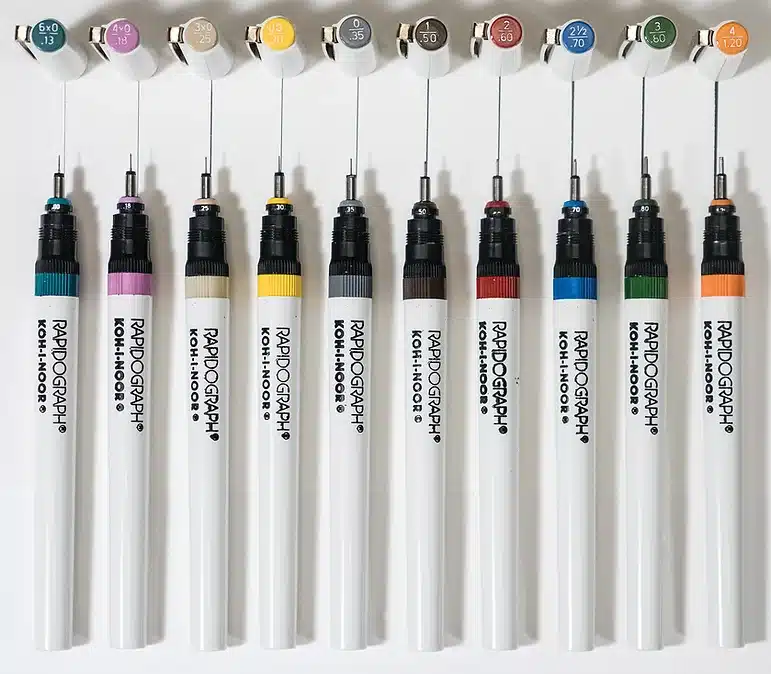
Koh-I-Noor’s Rapidograph technical pens have been around for generations; since long before computer generated graphics became mainstream and commonplace. For years, architects, engineers, and artists have all relied on Rapidographs for their ease of use, practicality, and precision. And it’s no wonder why so many people love them. For starters, these pens are specially designed to give artists consistent lines on a variety of paper-like surfaces. Creating smooth, precise, lines that can easily be scanned for clear and clean digital rendering. But, that is just one of the many features Rapidographs have to offer.
With their 10 line width sizes to choose from, it’s no wonder why so many artists use these pens. You have the ability to create ultra-fine lines, thick bold lines, and everything in between; the choice is yours! As such, they’re the perfect tool for illustrations, comics, hand lettering and so much more! Now, regardless of which size you choose, just know that all Rapidograph pens are made to last!
Each pen comes in a sleek white casing, in which lies the pens’ refillable ink reservoir and stainless steel nib tip. What’s more, each pen cap is color-coded for easy identification, and all caps are designed to be double-sealed to prevent any ink from drying out on your nib. However, just because the cap is double-sealed does not mean that you shouldn’t clean your nib! Any dried ink can damage your nib or cause difficulties when using it. In the off handed chance your nib is broken or damaged, Koh-I-Noor makes replacement tips and does offer services to fix your pen.
Now, let’s briefly go over what can and can’t you do with Rapidographs. I’ve slightly touched up on how Rapidographs can be used on “paper-like” surfaces, so let me explain what I mean a bit further. Generally speaking, any type of smooth, non-fibrous, surface can be used with Rapidograph pens. For example, marker paper, bristol-vellum, illustration board, and sketch or drawing papers are all recommended for any artworks involving Rapidographs.
The use of fibrous papers can lead to your pen clogging as the fibers from the paper can enter the pens opening. However, this is not the only way you can cause clogging in your pen. Shaking the pen up and down can cause the ink to essentially jam inside of the pen. The easiest solution to fix this is to use a bit of Rapido-Eze pen cleaner to flush out any stuck paper or ink.
Can I use any type of ink in my Rapidograph? The short answer is no! It’s not recommended to use any non Koh-I-Noor branded inks in your Rapidographs. Not all inks are made with the same viscosity, permanence, pigment load, or binding agents. Using any other ink can result in difficulties while using your pen, or can cause permanent damage. As stated earlier, in the offhanded chance your pen becomes defective, Koh-I-Noor does offer services to fix your pen for a fee. However, solutions to most of the commonly occurring problems you will face can be found online. Koh-I-Noor has a few YouTube videos and a pen care and information guide online for free with detailed instructions on how to properly care for and use your technical pen.
So what are Rapidographs? To summarize, Rapidographs are technical pens made by the brand Koh-I-Noor. Their metal tips come in 10 various sizes, ranging from .13mm to 1.20 mm and are best suited for illustrations, comics, hand lettering and various other artistic passions on smooth surfaces. Any artwork done with these pens can easily, cleanly, and clearly be scanned to a computer to achieve a digitally rendered copy. While these pens are generally long-lasting and easy to use, some precautions should be taken to extend the longevity of your pens. For example, you should clean your pen nib if you don’t plan to use it for an extended period of time, only use Koh-I-Noor branded technical pen inks in your pen, and you should always use a smooth surface when using your Rapidograph. While Koh-I-Noor does offer repair services for a fee, you can attempt to fix the problem yourself before sending it in to be repaired. Solutions to most of the commonly occurring problems can be found in Koh-I-Noors’ pen care and information guide listed on their website for free.
If any of this information has been helpful or has sparked your interest in Rapidographs, then we’d love to hear about it in the comments below! Happy creating!
sources:
Koh-I-Noor, ‘Precision Pens For Art And Technical Use’, https://www.kohinoorusa.com/rapidograph
